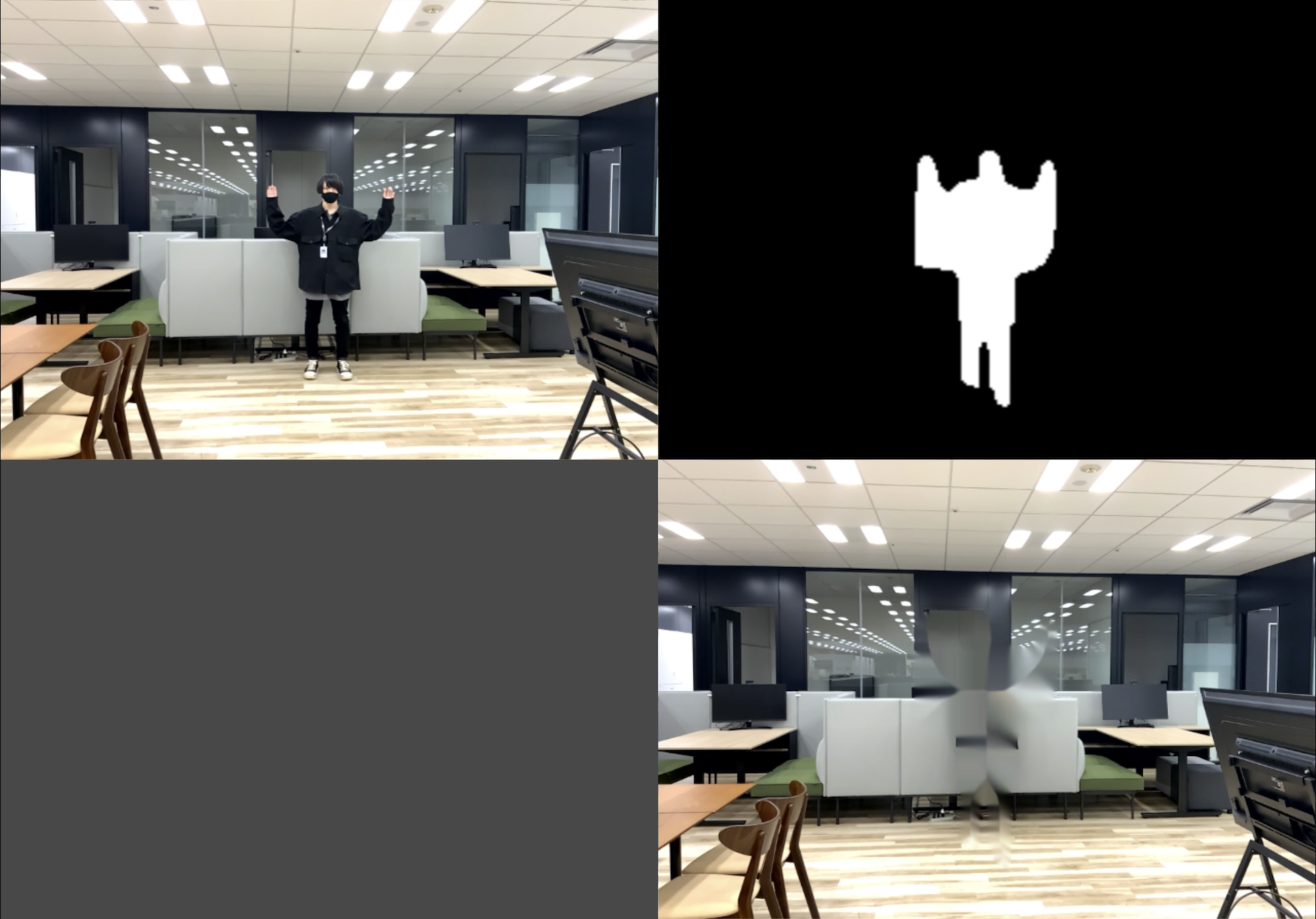概要
左上:カメラ画像 / 右上:マスク画像 / 左下:加工後画像
HumanStencilの取得はARFoundationを、画像の加工にはOpenCV plus Unityを使用しています。
手順としては以下3ステップです。
- ARFoundationからカメラ画像を取得する
- ARFoundationからHumanStencilを取得する
- 画像を加工して人を消す
ソースコード公開しています:https://github.com/AzetaTakuya/InvisibleHuman
環境
- iPad Pro 11インチ(第2世代)
- Unity 2021.2.0a8
- ARFoundation 4.1.0
- OpenCV plus Unity
実装
1. ARFoundationからカメラ画像を取得する
ARCameraManagerのコールバックから、カメラ画像を取得します
参考:https://docs.unity3d.com/Packages/com.unity.xr.arfoundation@4.1/manual/cpu-camera-image.html
[SerializeField] private ARCameraManager CameraManager;
private Texture2D RGB_Texture;
private void Start()
{
CameraManager.frameReceived += OnARCameraFrameReceived;
}
unsafe void OnARCameraFrameReceived(ARCameraFrameEventArgs eventArgs)
{
if (!CameraManager.TryAcquireLatestCpuImage(out XRCpuImage image)) return;
var conversionParams = new XRCpuImage.ConversionParams
{
inputRect = new RectInt(0, 0, image.width, image.height),
outputDimensions = new Vector2Int(image.width / 2, image.height / 2),
outputFormat = TextureFormat.RGBA32,
transformation = XRCpuImage.Transformation.MirrorY
};
int size = image.GetConvertedDataSize(conversionParams);
var buffer = new NativeArray<byte>(size, Allocator.Temp);
image.Convert(conversionParams, new IntPtr(buffer.GetUnsafePtr()), buffer.Length);
image.Dispose();
if (RGB_Texture == null)
{
var x = conversionParams.outputDimensions.x;
var y = conversionParams.outputDimensions.y;
RGB_Texture = new Texture2D(x, y, conversionParams.outputFormat, false);
}
RGB_Texture.LoadRawTextureData(buffer);
RGB_Texture.Apply();
buffer.Dispose();
}
2. ARFoundationからHuman Stencilを取得する
手順は以下の通りです。
- AROcclusionManagerのhumanStencilTextureを取得
- humanStencilTextureをGraphics.Blitで加工し、RenderTextureに出力
- 出力したRenderTextureをTexture2Dに変換
[SerializeField] private AROcclusionManager OcclusionManager;
[SerializeField] private Material HumanStencil_Material;
private RenderTexture HumanStencil_RT;
private Texture2D Stencil_Texture;
private void Update()
{
var currentStencil = OcclusionManager.humanStencilTexture;
if (currentStencil == null) return;
if (HumanStencil_RT == null)
{
HumanStencil_RT = RenderTexture.GetTemporary(currentStencil.width, currentStencil.height, 0, RenderTextureFormat.ARGB32, RenderTextureReadWrite.Linear);
HumanStencil_RT.Create();
}
if (Stencil_Texture == null)
{
Stencil_Texture = new Texture2D(currentStencil.width, currentStencil.height);
}
Graphics.Blit(currentStencil, HumanStencil_RT, HumanStencil_Material);
var currentRT = RenderTexture.active;
RenderTexture.active = HumanStencil_RT;
Stencil_Texture.ReadPixels(new UnityEngine.Rect(0, 0, Stencil_Texture.width, Stencil_Texture.height), 0, 0);
Stencil_Texture.Apply();
RenderTexture.active = currentRT;
}
3. 画像を加工して人を消す!!
手順は以下の通りです。
- HumanStencil
- グレースケール化
- 人物部分拡張
- 画像サイズ変更
- カメラ画像
- サイズ変更
- 画像反転
- 出力画像
- マスク画像を使ったカメラ画像の修正
[SerializeField] private RawImage RGB_Image;
[SerializeField] private RawImage HumanStencil_Image;
[SerializeField] private RawImage Inpaint_Image;
private int width = 640, height = 480;
private CancellationTokenSource tokenSource;
private void Start()
{
tokenSource = new CancellationTokenSource();
var cancelToken = tokenSource.Token;
_ = CaptureLoop(cancelToken);
}
private async Task CaptureLoop(CancellationToken cancelToken)
{
byte[] dilateArray =
{ 1, 1, 1, 1, 1,
1, 1, 1, 1, 1,
1, 1, 1, 1, 1,
1, 1, 1, 1, 1,
1, 1, 1, 1, 1, };
Texture2D stencilViewTexture = new Texture2D(width,height);
Texture2D rgbViewTexture = new Texture2D(width, height);
Texture2D inpaintViewTexture = new Texture2D(width, height);
HumanStencil_Image.texture = stencilViewTexture;
RGB_Image.texture = rgbViewTexture;
Inpaint_Image.texture = inpaintViewTexture;
while (!cancelToken.IsCancellationRequested)
{
await Task.Delay(20);
if (RGB_Texture == null || Stencil_Texture == null) continue;
using (Mat stencilMat = OpenCvSharp.Unity.TextureToMat(Stencil_Texture))
using (Mat rgbMat = OpenCvSharp.Unity.TextureToMat(RGB_Texture))
using (Mat inpaintMat = new Mat())
{
#region stencil texture
Cv2.CvtColor(stencilMat, stencilMat, ColorConversionCodes.BGR2GRAY);
Cv2.Dilate(stencilMat, stencilMat, InputArray.Create(dilateArray));
Cv2.Resize(stencilMat, stencilMat, new OpenCvSharp.Size(width, height));
stencilViewTexture = OpenCvSharp.Unity.MatToTexture(stencilMat, stencilViewTexture);
#endregion
#region rgb texture
Cv2.Resize(rgbMat, rgbMat, new OpenCvSharp.Size(width, height));
Cv2.Flip(rgbMat, rgbMat, FlipMode.Y);
rgbViewTexture = OpenCvSharp.Unity.MatToTexture(rgbMat, rgbViewTexture);
#endregion
#region inpaint
Cv2.Inpaint(rgbMat, stencilMat, inpaintMat, 3, InpaintMethod.NS);
inpaintViewTexture = OpenCvSharp.Unity.MatToTexture(inpaintMat, inpaintViewTexture);
#endregion
stencilMat.Dispose();
rgbMat.Dispose();
inpaintMat.Dispose();
}
}
}
InpaintMethodはNSとTeleaがありますが、NSの方が高速だった為NSを採用しています。
※ usingステートメントを使用してもMatのメモリが解放されないらしいので、加えてDispose()を読んでいます。実際はDispose()だけで良いと思います。
まとめ
AR×OpenCVは楽しい
参考
- #OpenCV Sharpでメモリリークが起きる
